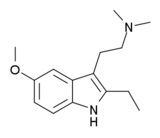
2-Ethyl-5-methoxy-N,N-dimethyltryptamine
Encyclopedia
2-Ethyl-5-methoxy-N,N-dimethyltryptamine (EMDT) is a tryptamine
derivative which is used in scientific research. It acts as a selective
5-HT6 receptor
agonist
, with a Ki
of 16 nM, and was one of the first selective agonists developed for this receptor. EMDT inhibits both short-
and long-term memory
formation in animal studies, and this effect can be reversed by the selective 5-HT6 antagonist SB-399,885
. Additionally, it is active in the tail suspension test
, suggesting that it could be an effective antidepressant
.
Tryptamine
Tryptamine is a monoamine alkaloid found in plants, fungi, and animals. It is based around the indole ring structure, and is chemically related to the amino acid tryptophan, from which its name is derived...
derivative which is used in scientific research. It acts as a selective
Binding selectivity
Binding selectivity refers to the differing affinities with which different ligands bind to a substrate forming a complex. A selectivity coefficient is the equilibrium constant for the reaction of displacement by one ligand of another ligand in a complex with the substrate...
5-HT6 receptor
5-HT6 receptor
The 5-HT6 receptor is a subtype of 5-HT receptor that binds the endogenous neurotransmitter serotonin . It is a G protein-coupled receptor that is coupled to Gs/Go and mediates excitatory neurotransmission. HTR6 denotes the human gene encoding for the receptor.-Distribution:The 5-HT6 receptor is...
agonist
Agonist
An agonist is a chemical that binds to a receptor of a cell and triggers a response by that cell. Agonists often mimic the action of a naturally occurring substance...
, with a Ki
Dissociation constant
In chemistry, biochemistry, and pharmacology, a dissociation constant is a specific type of equilibrium constant that measures the propensity of a larger object to separate reversibly into smaller components, as when a complex falls apart into its component molecules, or when a salt splits up into...
of 16 nM, and was one of the first selective agonists developed for this receptor. EMDT inhibits both short-
Short-term memory
Short-term memory is the capacity for holding a small amount of information in mind in an active, readily available state for a short period of time. The duration of short-term memory is believed to be in the order of seconds. A commonly cited capacity is 7 ± 2 elements...
and long-term memory
Long-term memory
Long-term memory is memory in which associations among items are stored, as part of the theory of a dual-store memory model. According to the theory, long term memory differs structurally and functionally from working memory or short-term memory, which ostensibly stores items for only around 20–30...
formation in animal studies, and this effect can be reversed by the selective 5-HT6 antagonist SB-399,885
SB-399,885
SB-399885 is a drug which is used in scientific research. It acts as a potent, selective and orally active 5-HT6 receptor antagonist, with a Ki of 9.0nM...
. Additionally, it is active in the tail suspension test
Tail suspension test
The tail suspension test is an experiment used to assay mood levels in rodents in scientific research. Changes in immobility time indicate changes in mood. It is widely used to detect potential antidepressant effects of drugs....
, suggesting that it could be an effective antidepressant
Antidepressant
An antidepressant is a psychiatric medication used to alleviate mood disorders, such as major depression and dysthymia and anxiety disorders such as social anxiety disorder. According to Gelder, Mayou &*Geddes people with a depressive illness will experience a therapeutic effect to their mood;...
.

